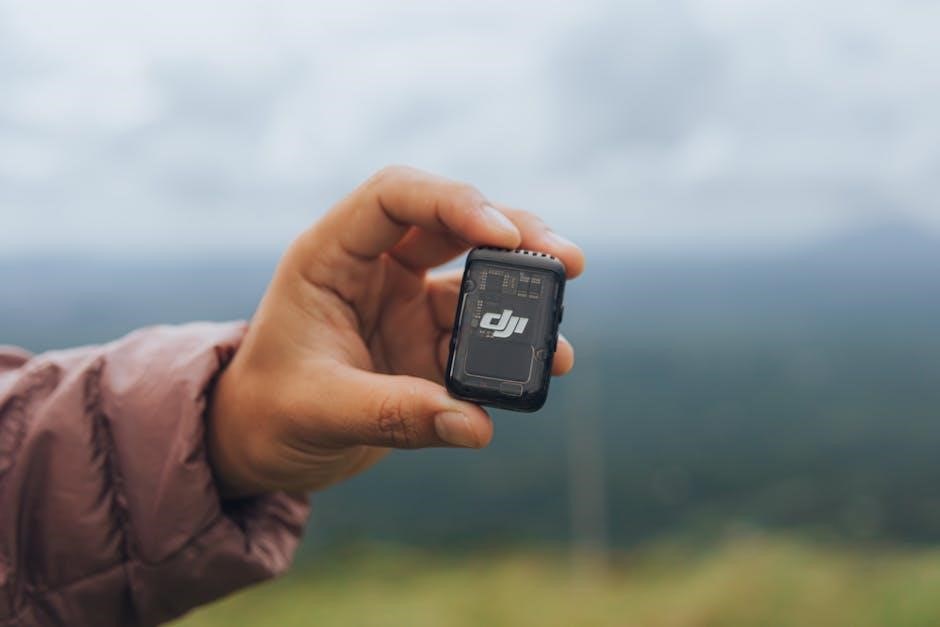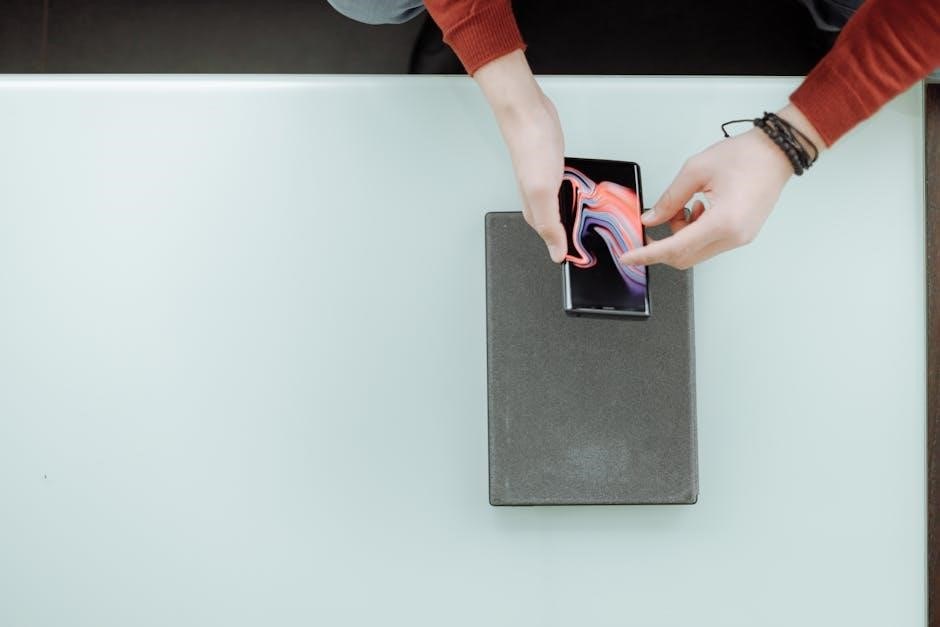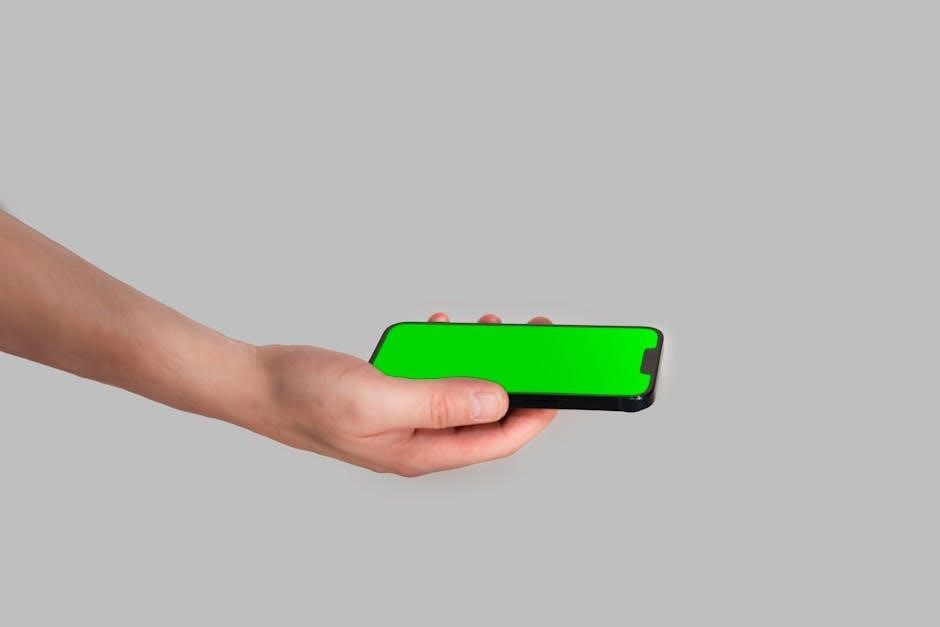Welcome to the IRIS Flip Phone Manual․ This guide provides essential information for setting up and using your device, including unboxing, key features, and safety guidelines․ Explore advanced functionalities and optimize your user experience with detailed instructions and troubleshooting tips․
1․1․ Purpose of the Manual
This manual is designed to guide users in understanding and utilizing the IRIS Flip Phone effectively․ It provides detailed instructions for setup, operation, and troubleshooting, ensuring a seamless experience․ The manual covers essential features, safety precautions, and advanced functionalities to help users maximize their device’s potential․ Whether you’re a new user or looking to explore more features, this guide offers comprehensive support to enhance your overall experience with the IRIS Flip Phone․
1․2․ Key Features of the IRIS Flip Phone
The IRIS Flip Phone combines sleek design with advanced features, offering a unique blend of functionality and ease of use․ It includes a high-resolution camera with manual focus and iris control, Wi-Fi connectivity, Bluetooth pairing, and a long-lasting battery․ The device supports eSIM setup, P2P functionality, and customizable home screens․ With its flip design and user-friendly interface, this phone is ideal for those seeking a modern yet familiar mobile experience․ Its intuitive menu navigation and robust feature set make it a versatile choice for everyday use․
1․3․ Safety Precautions
Before using your IRIS Flip Phone, read these safety precautions carefully․ Avoid direct eye exposure to the LED while it is on․ Do not use damaged cables or chargers, as they may cause malfunctions․ Keep the device away from water and extreme temperatures․ Follow proper handling guidelines to prevent physical damage․ Ensure compliance with local regulations for digital devices․ For any concerns or issues, refer to the manual or contact customer support․ Adhere to these guidelines to ensure safe and optimal use of your IRIS Flip Phone․

Unboxing and Initial Setup
Carefully unbox your IRIS Flip Phone and locate all components, including the charger, user manual, and SIM card tool․ Insert the SIM and SD cards, charge the battery, and follow the on-screen setup wizard to complete the initial configuration․
2․1․ Unboxing the IRIS Flip Phone
Begin by carefully opening the sealed packaging to reveal your IRIS Flip Phone․ Inside, you’ll find the phone, USB charger, user manual, SIM card ejector tool, and a quick start guide․ Inspect the device for any visible damage․ Ensure all components are included and undamaged․ Gently remove the protective film from the screen and camera lens․ Avoid touching the lens to prevent smudging․ Handle the SIM ejector tool with care to avoid damaging the phone․ This step ensures you’re ready for the initial setup process․
2․2․ Inserting the SIM and SD Cards
Open the back cover using the provided ejector tool or your fingernail in the small slot at the bottom․ Locate the SIM card slot on the side of the phone․ Align the SIM card’s gold contacts with the slot and gently push until it clicks․ For the SD card, insert it into the adjacent slot, ensuring it fits securely․ Close the back cover firmly․ Ensure both cards are properly seated to avoid damage or connectivity issues․ Follow the on-screen instructions to complete the setup process for your SIM and SD cards․
2․3․ Charging the Battery
Locate the charging port on the bottom of your IRIS Flip Phone․ Use the provided USB cable and adapter to connect the phone to a power source․ Ensure the cable is securely plugged in․ The battery icon will display charging status․ Avoid overcharging, as it may affect battery life; Charge the phone until the battery is fully charged, indicated by a full battery icon․ The phone may come partially charged, but it is recommended to charge it completely before first use for optimal performance․
Hardware and Physical Features
The IRIS Flip Phone features a sleek, lightweight design with a durable build․ It includes a compact keypad, intuitive navigation buttons, and essential ports for connectivity and charging․
3․1․ Overview of the Phone’s Design
The IRIS Flip Phone features a sleek, lightweight design with a durable build․ Its compact flip mechanism offers a classic aesthetic while maintaining modern functionality․ The phone includes a high-resolution display, a user-friendly keypad, and intuitive navigation buttons․ The exterior is crafted with premium materials, ensuring both style and durability․ The design emphasizes ease of use, with ergonomically placed controls and a comfortable grip․ Additionally, the phone’s port layout is strategically positioned for easy access to charging and data transfer ports․
3;2․ Button and Port Layout
The IRIS Flip Phone features a intuitive button layout designed for ease of use․ The keypad includes large, backlit buttons for clear visibility and comfortable dialing․ Navigation buttons are strategically placed for easy access to menu options and call functions․ The phone includes a standard charging port, headphone jack, and a dedicated camera button for quick access to imaging features․ Ports are conveniently located on the bottom or side, ensuring seamless connectivity and usability․ The design balances functionality with a sleek, user-friendly interface․
3․3․ Camera and Display Features
The IRIS Flip Phone boasts an impressive camera system with advanced features like auto-focus (AF) and iris control for precise image capture․ The display is a high-resolution, full-color screen designed for clarity and vibrant visuals․ It supports image flip and rotation options, enhancing user convenience․ The camera also includes safety features, such as warnings to avoid direct LED exposure․ The display’s flip mode allows for vertical image rotation, ensuring optimal readability and multimedia enjoyment․ These features combine to deliver a seamless and enjoyable user experience for photography and everyday use․

Basic Operations
Master essential functions like turning the phone on/off, navigating menus, and making calls․ Follow the guide for straightforward instructions to ensure smooth daily operation of your device․
4․1․ Turning the Phone On/Off
To turn the IRIS Flip Phone on, press and hold the power button for 3 seconds until the screen lights up․ Ensure the phone is fully charged before initial use․ To turn it off, press and hold the same button until the power menu appears, then select “Power Off․” Avoid forcing the phone off unless necessary․ Always use the power button to maintain proper functionality and battery health, as indicated in the manual․
4․2․ Navigating the Menu
Navigation on the IRIS Flip Phone is intuitive․ Use the navigation key to scroll through menu options․ Press the scroll key to select an item or confirm an action․ To move back, press the “Back” button or the red end call key․ Access the main menu by pressing the navigation key up or down․ Customize shortcuts for quick access to frequently used features․ The menu is user-friendly, ensuring easy operation for all users, as detailed in the manual․
4․3․ Making and Receiving Calls
To make a call, flip open the phone and dial the desired number using the keypad․ Press the call button (green key) to initiate the call․ To receive a call, press the call button when the phone rings․ Use the volume keys to adjust the call volume during a conversation․ To end a call, press the red end call button․ Ensure the phone is properly flipped open to maintain call clarity․ Manage calls efficiently with intuitive controls designed for a seamless communication experience․

Camera and Photo Settings
Configure your camera settings for optimal photography․ Adjust iris, autofocus, and flip options for desired image results․ Use the OSD menu to enable or disable features like WDR and vertical flip for enhanced captures․
5․1․ Using the Camera
To use the camera on your IRIS Flip Phone, open the camera app from the home screen or shortcut․ Navigate through the OSD menu to access settings like iris control, autofocus, and image flip․ Select manual mode for precise adjustments, ensuring optimal focus and lighting․ Capture photos by pressing the shutter button or using the volume key․ Review your images in the gallery and apply additional settings if needed․ Follow safety guidelines to avoid direct LED exposure during use․
5․2․ Adjusting Camera Settings (Iris, AF, etc․)
Access the camera settings through the OSD menu to adjust features like iris control, autofocus (AF), and image flip․ Select manual mode in the OSD menu for precise adjustments․ Adjust the iris to control light exposure and focus on subjects using AF mode․ Enable or disable image flip for vertical display reversal․ Ensure safety by avoiding direct LED exposure during adjustments․ These settings enhance photo quality and customization, allowing you to capture images with optimal clarity and desired effects․
5․3․ Image Flip and Rotation Options
Explore the image flip and rotation options to customize your photos․ Enable flip mode in the OSD menu to invert images vertically․ You can also rotate images in 90-degree increments for desired orientations․ These features are ideal for creative editing or correcting photo orientations․ Use the flip function to create mirrored effects or fix upside-down images․ Rotation options ensure your photos are displayed as intended, enhancing your overall camera experience with versatile adjustments․

Connectivity and Network
Configure Wi-Fi, Bluetooth, and cellular networks seamlessly․ Easily connect to wireless networks, pair devices via Bluetooth, and manage mobile data settings for reliable connectivity on your IRIS Flip Phone․
6․1․ Setting Up Wi-Fi
To connect your IRIS Flip Phone to a Wi-Fi network, go to Settings and select Wi-Fi․ Enable Wi-Fi and choose your desired network from the list․ Enter the password when prompted and tap Connect․ Ensure the network is within range for a stable connection; If issues arise, restart your router or forget the network and reconnect․ This feature enhances internet browsing, app updates, and streaming on your device․ Manage connected networks and customize settings for optimal performance․
6․2․ Bluetooth Pairing
To pair your IRIS Flip Phone with a Bluetooth device, go to Settings and select Bluetooth․ Enable Bluetooth and search for available devices․ Choose the desired device from the list and follow prompts to complete pairing․ Enter a passcode if required․ Once connected, you can transfer files, stream audio, or sync data․ Ensure both devices are in range for a stable connection․ If pairing fails, restart both devices and try again․ This feature allows seamless wireless connectivity for enhanced functionality and convenience․
6․3․ Cellular Network Configuration
To configure your IRIS Flip Phone’s cellular network, go to Settings > Network & Internet > Mobile Network․ Select Manual mode and choose your carrier from the list․ If prompted, enter your APN settings, which can be obtained from your service provider․ Enable IPv4 or IPv6 based on your network requirements․ Restart your phone after saving changes to apply the new configuration․ Ensure your SIM card is properly inserted and that you are in a coverage area for optimal connectivity․

Customization and Settings
Personalize your IRIS Flip Phone by adjusting settings to suit your preferences․ Customize the home screen, adjust display settings, and manage user accounts for a tailored experience․
7․1․ Personalizing the Home Screen
Personalize your IRIS Flip Phone’s home screen by adding widgets, changing wallpapers, and organizing apps․ To add widgets, press and hold an empty area, then select the desired widget․ Customize shortcuts for quick access to frequently used features․ Adjust the layout by dragging and dropping icons or folders․ To change the wallpaper, go to Settings > Display > Wallpaper․ Explore themes to match your style and enhance usability․ These customizations allow you to tailor your phone’s interface to your preferences for a seamless user experience․
7․2․ Adjusting Display Settings
Customize your IRIS Flip Phone’s display settings to enhance visibility and comfort․ Adjust brightness levels manually or enable auto-brightness for optimal screen illumination․ Set screen timeout duration to conserve battery life․ Choose from various font sizes and styles for readability․ Enable or disable auto-rotation based on your preference․ Access these settings via the Settings menu under the Display section․ Personalize your viewing experience by tweaking these options to suit your needs and preferences for a more enjoyable interaction with your device․
7․3․ Managing User Accounts
Efficiently manage user accounts on your IRIS Flip Phone to maintain privacy and organization․ Add or remove user profiles by navigating to the Settings menu and selecting the Users option․ Each profile can have customized settings and restrictions․ Switch between accounts easily for shared use․ Ensure each user has appropriate permissions and access levels․ Regularly review and update account settings to maintain security․ For multiple users, set up separate profiles to keep data and preferences distinct․ Refer to the manual for advanced account management options and troubleshooting tips․

Advanced Features
Explore advanced functionalities like P2P connectivity, eSIM activation, and mobile client setup․ This section provides detailed instructions to enhance your IRIS Flip Phone experience with ease․
8․1․ Using the P2P Functionality
The P2P (Peer-to-Peer) functionality on your IRIS Flip Phone allows seamless device-to-device communication․ To enable P2P, navigate to the Settings menu, select “Advanced Features,” and activate the P2P option․ Ensure both devices have the feature enabled and are connected to the same network․ Once activated, you can share files, photos, and videos directly between devices without internet connectivity․ This feature enhances collaboration and data transfer efficiency, making it ideal for quick sharing in professional or personal settings․
8․2․ eSIM Setup and Activation
To set up and activate the eSIM on your IRIS Flip Phone, go to the Settings menu and select “Advanced Features․” Choose “eSIM” and follow the on-screen instructions to download the eSIM profile․ Enter the activation code provided by your carrier․ Once activated, your device will connect to the cellular network․ Ensure your phone is updated to the latest software for optimal eSIM functionality․ This feature offers convenience and flexibility, allowing you to manage multiple network profiles effortlessly without a physical SIM card․
8․3․ Mobile Client Configuration
To configure the mobile client on your IRIS Flip Phone, open the Settings app and navigate to “Advanced Features․” Select “Mobile Client” and follow the on-screen instructions to install the necessary software․ Once installed, enable P2P functionality and enter your credentials․ Ensure IPv4 or IPv6 is selected based on your network requirements․ After configuring, restart your device to apply the settings․ For further assistance, refer to the vEye Operation Software manual or consult your network administrator․

Maintenance and Care
Regularly clean your IRIS Flip Phone with a soft cloth, avoiding harsh chemicals․ Handle the device gently to prevent scratches․ Ensure no direct eye exposure to the LED while it’s on․ Regular maintenance ensures longevity and optimal performance of your phone․
9․1․ Cleaning the Phone
Regular cleaning ensures your IRIS Flip Phone remains in optimal condition․ Use a soft, dry cloth to wipe the exterior and interior gently․ Avoid harsh chemicals or abrasive materials, as they may damage the finish or screen․ For stubborn marks, dampen the cloth slightly with water, but ensure it’s not soaking wet․ Never spray liquids directly onto the phone․ Avoid touching the camera lens to prevent smudging․ Clean the LED area carefully to maintain its functionality․ Regular cleaning prevents dust buildup and ensures clear display and camera performance․ Use a microfiber cloth for best results․
9․2․ Updating Software
Regular software updates ensure your IRIS Flip Phone runs smoothly and securely․ To update, go to Settings > System > Software Update․ Check for available updates and follow on-screen instructions․ Ensure a stable internet connection before proceeding․ Backup important data to prevent loss during the update․ Allow the phone to restart and complete the installation process․ Keep your device up-to-date to access new features, bug fixes, and enhanced performance․ Updates are crucial for maintaining optimal functionality and security․
9․3․ Battery Care Tips
To extend your IRIS Flip Phone’s battery life, avoid extreme temperatures and prevent drainage below 10%․ Charge regularly to maintain health․ Avoid overcharging by unplugging once fully charged․ Use the original charger for optimal performance․ Store the phone with a 50% charge if not in use for long periods․ Update software regularly for battery optimizations․ Clean charging ports to ensure proper connectivity․ Replace the battery if it shows signs of swelling or degradation․ Proper care ensures consistent performance and prolongs battery lifespan․

Troubleshooting Common Issues
This section provides solutions for common problems, such as connectivity issues, camera malfunctions, and performance lag․ Follow step-by-step guidance to resolve issues and restore functionality efficiently․
10․1․ Resolving Connectivity Problems
Experiencing connectivity issues? Restart your phone and router, then reconnect to Wi-Fi․ Ensure Bluetooth devices are in range and properly paired․ For cellular issues, check signal strength and verify APN settings․ Reset network settings if problems persist․ Enable airplane mode and disable it to refresh connections․ Ensure all software updates are installed․ Consult the manual for detailed troubleshooting steps or contact support for further assistance․ These steps help restore connectivity efficiently․
10․2․ Fixing Camera Malfunctions
Encountering camera issues? Restart the camera app or device․ Clean the lens with a soft cloth to remove smudges․ Ensure AF Mode is enabled in settings․ Check for software updates, as outdated software can cause malfunctions․ Reset camera settings to default if necessary․ If problems persist, perform a factory reset or contact support․ These steps help resolve common camera-related problems efficiently and restore functionality․
10․3․ Addressing Performance Lag
Experiencing performance lag? Restart your device to clear temporary glitches․ Close unused apps running in the background․ Ensure your software is up to date, as updates often improve performance․ Clear cached data from apps in settings․ Disable animations or reduce display effects․ If lag persists, perform a factory reset after backing up data․ These steps help optimize your phone’s performance and restore smooth functionality․

Maximizing Your IRIS Flip Phone Experience
Maximize your IRIS Flip Phone experience by exploring pre-installed apps, utilizing flip-specific features, and optimizing settings for enhanced performance and battery life․
11․1․ Exploring Pre-Installed Apps
Your IRIS Flip Phone comes with a selection of pre-installed apps designed to enhance your experience․ The Camera app offers features like iris focus and AF modes, while the Settings app allows customization․ Explore tools for managing files, notes, and utilities․ Access these apps by navigating through the menu, where you can also discover additional features like the P2P functionality and mobile client setup․ Familiarize yourself with these apps to unlock your phone’s full potential and streamline your daily tasks for a seamless user experience․
11․2․ Utilizing Flip Phone-Specific Features
The IRIS Flip Phone offers unique features that enhance its functionality and user experience․ The flip design allows for a compact form factor, while the physical keypad provides tactile feedback for easy navigation․ Take advantage of one-touch buttons for quick access to frequently used apps or functions․ The phone’s durability and long battery life make it ideal for everyday use․ Explore these flip-specific features to optimize your experience and enjoy a blend of simplicity and efficiency in your communication needs․
11․3․ Tips for Efficient Usage
Maximize your IRIS Flip Phone experience with practical tips․ Use the physical keypad for quick dialing and shortcuts․ Organize your apps and contacts for easy access․ Utilize the flip design to answer or end calls instantly․ Customize your home screen with frequently used features․ Adjust display settings to conserve battery life․ Regularly update your software for optimal performance․ Clean your phone regularly to maintain functionality․ Explore the P2P functionality for enhanced connectivity․ These tips ensure a seamless and efficient user experience tailored to your needs․